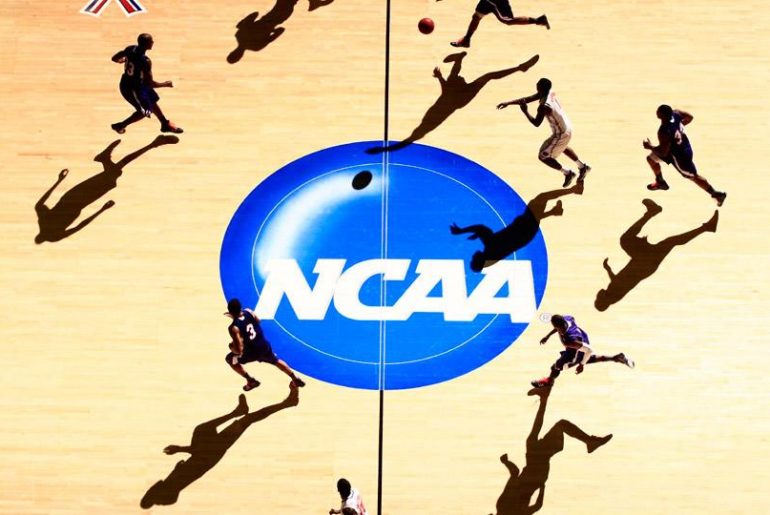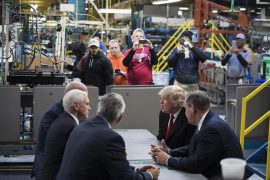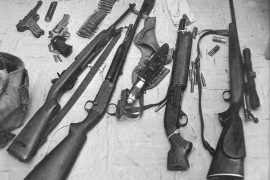[This article originally appears on the Society for US Intellectual History blog http://s-usih.org/2015/02/invisible-men.html.]
In his seminal works – Shadow and Act and Invisible Man – Ralph Ellison created two metaphors that speak to one of America’s great dilemmas regarding African Americans: how do Americans reconcile their beliefs in ‘democracy’ with certain ‘anti-democratic’ practices? The first appears in Shadow and Act, a book of essays, in which Ellison describes the African American as a Giant upon whom all of American history ‘unfolds’, a ‘human natural resource’ that must be restrained to preserve national power and stereotyped to preserve national innocence.[1] The second metaphor, the ‘battle royal’, appears in an earlier work The Invisible Man which explores what happens when the metaphorical giant attempts to break the chains and shape its destiny.[2] While both metaphors spoke explicitly to slavery and Jim Crow, they echo today in a variety of American institutions, the most ironic and obvious example is Big Time College Sports.
College sports is a multi-billion dollar industry with most of its revenue being created by two sports – football and basketball. So, a top football recruit is worth an additional $500k and a top basketball recruit is worth an additional $1.5 million to their respective programs.[3] The players in these sports are predominately black and get a very small portion of the wealth that they create. In the era of the student entrepreneur – Mark Zuckerberg, Bill Gates, et al – is a bit ‘peculiar’ to say the least. Our society has no problem with students profiting from their work in theory or principle, unless it involves this small group of people euphemistically labeled ‘student athletes’.
In the essay 20th Century Fiction and the Black Mask of Humanity in Shadow and Act, Ellison attempts to explain the absence of black humanity in the popular fiction of his day. Blacks were either caricatures or completely absent. To understand this dynamic, Ellison argued that the Negro should be thought of as a Giant, a bit like Gulliver’s. As long as the Giant accepted restraints and continued to provide sustenance he was not a problem. However, emancipation and the years leading up to Reconstruction gave the Giant the opportunity to exercise its will: politically, economically and also psychologically. Blacks began voting, owning property, and shaping culture. This created the need for not only countermeasures like political and economic disenfranchisement but also stereotypes to justify those countermeasures. The black would be recast as a brute that needed to be monitored for the benefit of the public or a child that needed to supervised for the benefit of himself.
The Giant in college sports is the black athlete and he encounters similar forces. Every dimension of college sports is reframed to make the exploitation of the athlete possible, profitable and seemingly necessary for the athlete’s own betterment. The coach is recast as a kind of missionary saving wayward young men from the perils of the ghetto rather than an extremely well compensated employee. The university is reimagined as a neutral, even reluctant, participant in sports rather than the beneficiary of free labor worth tens of millions of dollars. The NCAA is reframed as an objective enforcement organization rather than a cartel that controls college sports for a profit. Boosters are recast as an outside contagion rather than key contributors to and beneficiaries of college sports. Education itself is redefined and reshaped to fit the needs of the college sports industry, not the actual athletes. And of course the athletes themselves, black athletes in particular, are recast as young men in desperate need of control or protection. The athlete then signs away his privacy, economic freedoms, personal likeness, and potentially his health, for the longshot chance of becoming a professional athlete or the ‘opportunity’ to get an education. When the athlete challenges the exploitation and paternalism of this arrangement – when the Giant pulls at his restraints – he is reminded of the Faustian bargain he has made in trading inequality for ‘opportunity’. Ellison explores this dynamic in the battle royal scene in Invisible Man.
Invisible Man chronicles the life of an unnamed protagonist struggling to survive in a world that refuses to acknowledge his equality, humanity and seemingly his very existence. The protagonist, a high school valedictorian, is invited to deliver his graduation speech to a gathering of white community leaders, but before he can deliver the speech he must participate in a cage brawl with a group of other young black men. The scene reads like a lurid, fever dream. The young men are goaded with liquor. They are tempted by a gyrating white stripper. Then after the initial brawl, they must again fight one another for money on an electrified carpet. When this is over, beaten and bloodied, our protagonist is given an opportunity to deliver his speech on black ‘responsibility’ – and that is when the trouble starts. In his subconscious or perhaps conscious mind, he wants to lay claim to black equality, so during the speech he lapses and rather than arguing for ‘black responsibility’ a vague trope, he argues for ‘black equality’ infuriating his audience. When they express their outrage he quickly corrects himself, profusely apologizing. His reward is a scholarship to a local Negro college. The price of progress is brutalization, inequality, and paternalism.
Similarities between Ellison’s battle royal and college sports abound. Football has become increasingly violent over the years, particularly the seasoning process that the rookie undergoes to win the respect of experienced players. Myron Rolle, a former FSU player and Rhodes Scholar, describes his own teams tradition of making rookie players box veteran players at the end of practice to prove their toughness. The recruiting process also mirrors Ellison’s battle royal in some interesting ways. Many schools have ‘recruiting hostesses’ attractive young women who throw parties for prospective recruits plying them with food, attention, and at the University of Tennessee lots of ‘eye contact and touching’.[4] The lure of financial reward and subsequent punishment is ever present. Booster clubs, closely affiliated with the schools, pay for access to the games and the athletes often giving them jobs or money. All of the actors in this farce are there because of the athlete, but if the athlete pursues a reward commensurate with his contribution – if he demands equality – he is condemned, demonized and expelled.
Ellison, himself a varsity football player, would often sit perched in his window and watch young men play basketball on the court below his apartment building.[5] For Ellison, watching the young men play was like peering into both the past and the future. Would the young men’s abilities be considered a ‘gift’ that represented an entitlement for someone else? Or would they be an asset for which they are due the rewards? The past had established a model about which Ellison had written extensively, but perhaps the future would be different. However, in transforming the athlete into a person whose ability is maximized for the sake of profit, but minimized for the sake of power, college sports grafts the worst of the past onto the present and answers Ellison’s questions in truly disturbing ways.
[1] Ellison, Ralph, and John F. Callahan. The Collected Essays of Ralph Ellison. Modern Library ed. New York: Modern Library, 1995. 85.
[2] Ellison, Ralph. Invisible Man. 2nd Vintage International ed. New York: Vintage International, 1995. 17-35.
[3] Clotfelter, Charles T. Big-time Sports in American Universities. Cambridge: Cambridge University Press, 2011. 118.
[4] Clotfelter 120
[5] Ellison and Callahan 385



